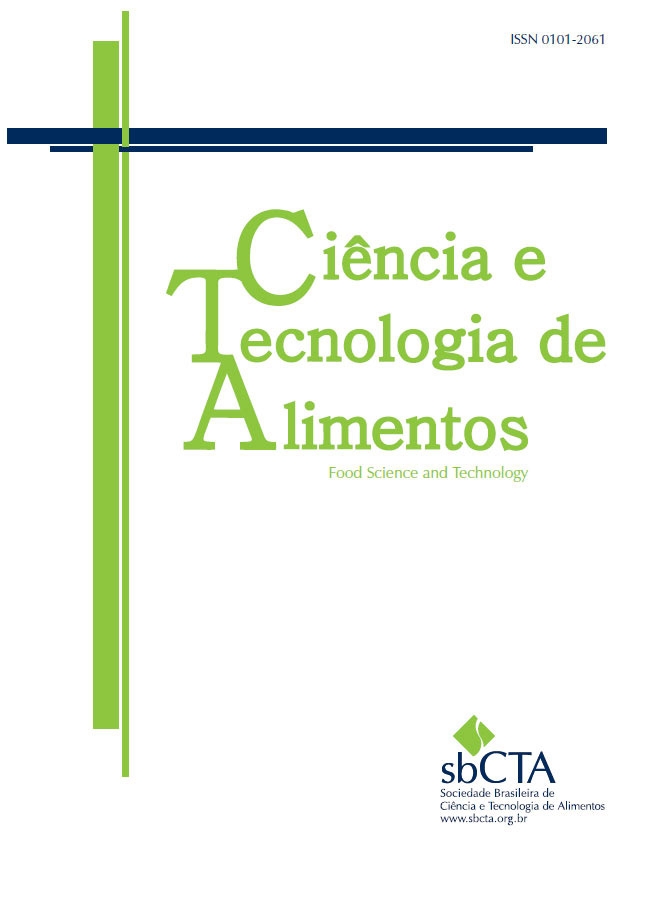Development and characterization of a nut-based beverage of Brazil nut (Bertholletia excelsa) and macadamia (Macadamia integrifolia)
DOI:
https://doi.org/10.5327/fst.02223Palavras-chave:
non-dairy milk, water-soluble extract, lactose free, stability, storageResumo
Brazil nuts and macadamia nuts are highly nutritious and can be used for the production of plant-based beverages. Considering the need to develop new beverages alternative to cow milk, the aim of this study was to develop water-soluble extracts based on Brazil nuts and macadamia nuts using an experimental design for simplex centroid mixtures in order to evaluate the proximate composition of the ternary mixture. The best beverage formulation was established based on sensory acceptance and shelf life, which was determined through microbiological aspects during refrigerated storage. The most accepted formulation consisted of 60% (w/w) of water, 20% (w/w) of Brazil nuts, and 20% (w/w) of macadamia nuts. The nut-based beverage presented a yellow–white color, and it was in accordance with the microbiological standards established by the Brazilian legislation, with an estimated shelf life of 28 days.
Downloads
Referências
Barbosa, M. L. S., de Alencar, E. R., Leandro, E. dos S., Borges, R. M., Mendonça, M. A., & Ferreira, W. F. de S. (2020). Characterization of fermented beverages made with soybean and Brazil nut hydrosoluble extracts. International Journal of Gastronomy and Food Science, 21, 100228. https://doi.org/10.1016/j.ijgfs.2020.100228
Bligh, E. G., & Dyer, W. J. (1959). A rapid method of total lipid extraction and purification. Canadian Journal of Biochemistry and Physiology, 37(8), 911-917. https://doi.org/10.1139/o59-099
Brasil (2001). Ministério da Saúde. Agência Nacional de Vigilância Sanitária. Regulamento técnico sobre os padrões microbiológicos para alimentos. Resolução RDC nº 12, 2 de janeiro de 2001.
Brasil (2002). Resolução—RDC no 275, de 21 de outubro de 2002.
Cardoso, C. F., Santos, M. G. dos, Silva, Y. P. A., Canedo, M. S., Garcia, L. G. C., & Silva, F. A. (2020). Processing, characterization and stability of Brazil nut (Bertholletia excelsa) extract. Research, Society and Development, 9(5), e137953292. https://doi.org/10.33448/rsd-v9i5.3292
Chim, J. F., Zambiazi, R. C., & Rodrigues, R. S. (2013). Estabilidade da vitamina C em néctar de acerola sob diferentes condições de armazenamento. Revista Brasileira de Produtos Agroindustriais, 15(4), 321-327. https://doi.org/10.15871/1517-8595/rbpa.v15n4p321-327
Condori, M. Z., Vega, R. F. C., & Hughes, K. M. (2019). Peruvian Brazil Nuts. In Pullanikkatil, D. & Shackleton, C. M. (Eds.), Poverty Reduction through non-timber forest products: personal stories (pp. 125-129). Springer International. https://doi.org/10.1007/978-3-319-75580-9_20
Feng, P., Weagant, S. D., Grant, M. A., & Burkhardt, W. (2020). BAM Chapter 4: Enumeration of Escherichia coli and the Coliform Bacteria. FDA. Retrieved from https://www.fda.gov/food/laboratory-methods-food/bam-chapter-4-enumeration-escherichia-coli-and-coliform-bacteria
Horwitz, W. (2010). Official methods of analysis of AOAC International (vol. 1). AOAC International. Retrieved from https://repositorioinstitucional.ceu.es/handle/10637/3158
Huang, W., Dong, A., Pham, H. T., Zhou, C., Huo, Z., Wätjen, A. P., Prakash, S., Bang-Berthelsen, C. H., & Turner, M. S. (2023). Evaluation of the fermentation potential of lactic acid bacteria isolated from herbs, fruits and vegetables as starter cultures in nut-based milk alternatives. Food Microbiology, 112, 104243. https://doi.org/10.1016/j.fm.2023.104243
Nolden, A. A., & Forde, C. G. (2023). The nutritional quality of plant-based foods. Sustainability, 15(4), 3324. https://doi.org/10.3390/su15043324
Sadler, G. D., & Murphy, P. A. (2010). PH and titratable acidity. In Nielsen, S. S. (Ed.), Food analysis (pp. 219-238). Springer US. https://doi.org/10.1007/978-1-4419-1478-1_13
Salfinger, Y., & Tortorello, M. L. (2013). Compendium of methods for the microbiological examination of foods. American Public Health Association. https://doi.org/10.2105/MBEF.0222
Singh-Ackbarali, D., & Maharaj, R. (2014). Sensory evaluation as a tool in determining acceptability of innovative products developed by undergraduate students in food science and technology at the University of Trinidad and Tobago. Journal of Curriculum and Teaching, 3(1), 10-27. https://doi.org/10.5430/jct.v3n1p10
Vasquez, W. V., Hernández, D. M., del Hierro, J. N., Martin, D., Cano, M. P., & Fornari, T. (2021). Supercritical carbon dioxide extraction of oil and minor lipid compounds of cake byproduct from Brazil nut (Bertholletia excelsa) beverage production. Journal of Supercritical Fluids, 171, 105188. https://doi.org/10.1016/j.supflu.2021.105188
Xia, C., Jiang, S., Tan, Q., Wang, W., Zhao, L., Zhang, C., Bao, Y., Liu, Q., Xiao, J., Deng, K., He, M., An, P., Wang, W., Zou, M., Xia, Z., Xia, C., Jiang, S., … & Xia, Z. (2022). Chromosomal-level genome of macadamia (Macadamia integrifolia). Tropical Plants, 1, 3. https://doi.org/10.48130/TP-2022-0003
Yang, J., Lee, R., Schulz, Z., Hsu, A., Pai, J., Yang, S., Henning, S. M., Huang, J., Jacobs, J. P., Heber, D., & Li, Z. (2023). Mixed nuts as healthy snacks: effect on tryptophan metabolism and cardiovascular risk factors. Nutrients, 15(3), 569. https://doi.org/10.3390/nu15030569



